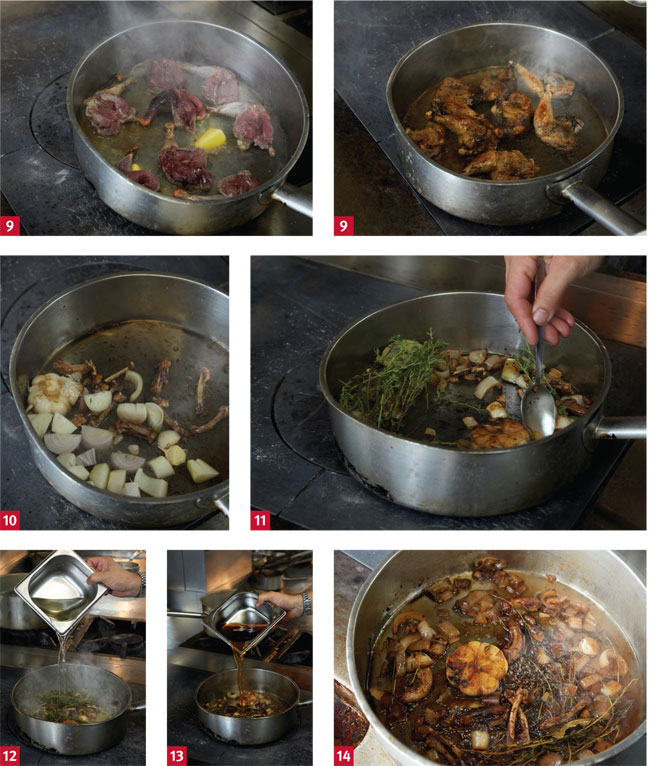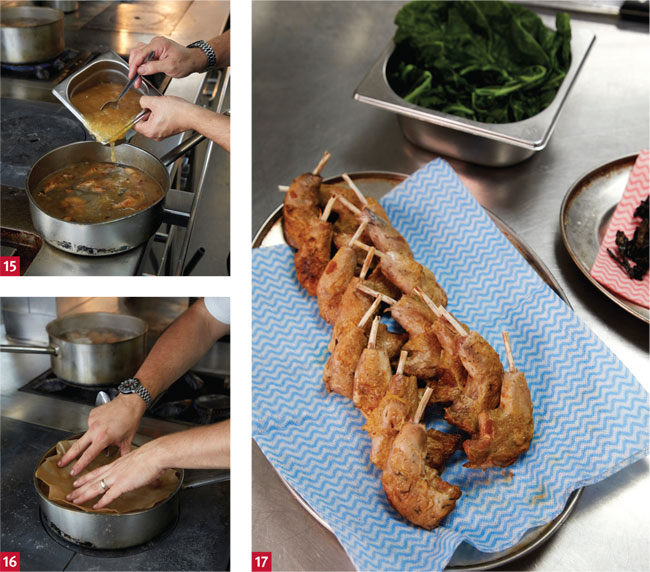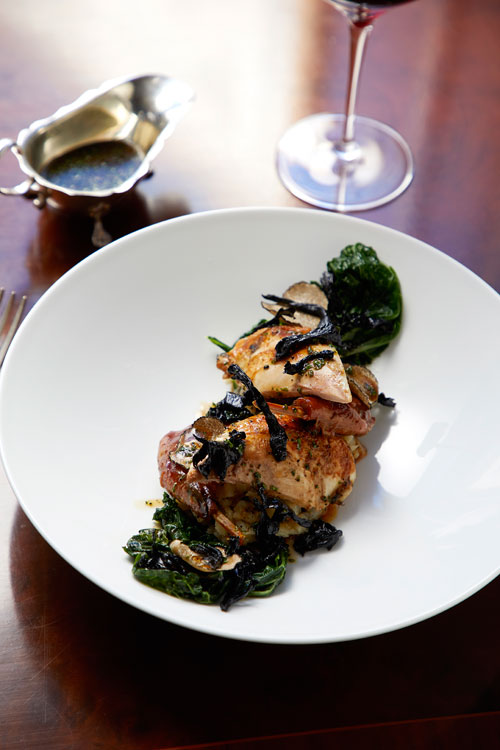Masterclass: Partridge with James Durrant
James Durrant, executive chef of the Game Bird restaurant at the Stafford London hotel in St James's, prepares a hearty partridge dish full of autumnal flavours. Michael Raffael reports
Like pheasants, the partridges sold to chefs are, for the most part, farmed game birds. Estates rear them in pens, release them and they are shot. The season lasts from September until 1 February, and supply and demand means they are about a third of the price of grouse.
The upside is that, because of the way they are reared, there is an element of quality control and they tend to be consistent in size, age and condition. They are reared outdoors, so are more ‘free-range' than the equivalent chickens, ducks or turkeys. The downside is that all will exhibit some trace of shot damage.
There are two kinds of partridge: the indigenous grey partridge, which has become a 'rare bird', especially in the wild; and the red-legged (or French) partridge, which has been reared by land owners for more than two centuries. Is one better than the other? According to La Cuisinière Cordon Bleu: "Red-legged partridges are rated higher than the grey ones in countries where they are scarcer and vice versa, which only proves they are as good as each other."
What has changed, though, is the attitude to the birds' sex. In the past, hens were always chosen for roasting and cocks for stews. Now, the two are almost always interchangeable.
Sourcing and batch size
The Game Bird prepares the birds in batches of 20 to 40. It buys from two sources: the Cowdray Estate in West Sussex (www.cowdray.co.uk) or Scotland-based Braehead Foods (www.braeheadfoods.co.uk). The suppliers deliver them New York dressed (ie with the carcass plumage dry-plucked and undrawn).
Costs
Each partridge (one per portion) costs the kitchen about £1.80. Other ingredients including truffle paste and tuber indicum truffles double the cost. It will sell on the Á la carte menu for £26.50, which yields an approximate 80% gross profit.
Planning
•Basic butchery of the partridges.
•Braise the legs.
•Reduce the sauce base and prepare the glaze.
•Prepare the celeriac, Hispi cabbage and mushroom accompaniments.
•Roast to order, reheat the legs, finish the sauce and plate.
Basic butchery
Chop off the wings as close to the carcass as possible and discard them (1). Cut off the head as close to the skull as possible (2). Lay the bird with the backbone facing you. Slit the skin along the neck to expose the neck and cut it off where it joins the carcass, and reserve it for stock (3). Extract the crop (where the bird stores any ingested grains) with your fingers (4).
Fold the neck skin under the carcass and burn off any loose feathers with a blow torch (5). Remove the two legs as you would a chicken's: cut through the skin between the body and the legs; dislocate the joint, and pull off the leg (6). Expose the thigh bone by scraping along it with a sharp knife and cut the joint to the drumstick (7). Extract both thighbones and keep back for stock. Reserve the legs.
Slit between the parson's nose and the endof the keel bone. Grasp the backbone and twist to snap it. Pull it off the carcass with the entrails attached. Wipe the inside of the carcass thoroughly (8).
Braising the legs
Note: for the photos, Durrant braised eight legs to show the process instead of the full batch. When scaling up, work on the basis of one head of garlic and 200g chopped shallots per litre of liquid.
Sprinkle a little salt on the legs. Heat about 30ml oil in a sauté pan and sear the legs until they start to colour. Add 30g butter and finish browning the skin, and then remove the legs from the pan (9). Brown the necks and thighbones in the same pan. Add the shallots and garlic and fry until the surface caramelises (10).
Add a generous bunch of fresh thyme to the pan and then pour in 150ml dry white wine and reduce to a glaze. Pour in 150ml Madeira and reduce to a glaze again (11-14). Add the browned legs back to the pan and cover completely in three parts white chicken stock to one part brown chicken stock (see panel), about 750ml in all (15). Cover the surface with a paper cartouche and simmer for one hour (16). Remove the cooked thighs, chill and reserve. Discard the bones (17).
Sauce base and glaze
To make a full batch of the braising stock, multiply the proportions given for braising the legs (above) by a factor of 10. To make the sauce base, reduce one half of the stock (about four litres) to two litres. To make the glaze, reduce the other four litres to about 500ml, pour into a squeezy bottle and reserve. Add 70ml of the glaze to finish the sauce and keep the rest to brush the legs during plating.
Roast partridge, truffled celeriac, Hispi cabbage
Serves 2
Note: To illustrate the difference between a crown correctly roasted and one left underdone on purpose as a practical solution during a busy service, Durrant roasted two birds (18).
4 braised partridge legs
Sauce base to reheat (about 300ml)
60ml sunflower/pomace oil
Salt
2 partridge crowns
100g butter
1tbs partridge sauce glaze
1tsp chopped chives
10ml approx extra virgin olive oil
120g mashed celeriac
2 large blanched Hispi cabbage leaves
Sautéed trompettes des morts
2 slices summer truffle
Prepare a rack over a drip tray. Gently reheat the legs in the sauce base in a small sauté pan on the side of the range (19). Heat the oil in a pan just large enough to take the two crowns. Season the birds and start to colour them on all sides in hot oil (20). Add the butter and let it foam without burning or turning to beurre noisette (21). Baste the crown thoroughly for about three minutes (22).
Tip: If the surface feels like a rare steak when prodded, the breast is still underdone. It's ready if there's still a little give.
Lay the birds breast-down on the prepared rack. Pour the hot butter into the breast cavities and rest about five minutes (23). Brush the legs with the glaze. Finish the sauce by reducing to a light coating consistency. Add the chives, truffle paste and oil. Pour into a sauce boat and keep hot. Carve the supremes off the partridge crowns (underdone breasts can be flashed under a salamander for a minute after carving).
Arrange the cabbage leaves and celeriac on the plate. Put the two breasts and two legs on top. Finish with the trompettes des morts and slices of truffle. Serve the sauce separately.
"It's been lovely to come back to London and gain some recognition," says James Durrant.
The chef took the helm of the Game Bird restaurant at the Stafford London hotel after four years running his pub, the Plough Inn at Longparish in Hampshire.
It was Durrant's first major break after spending 10 years in the Gordon Ramsay empire. The experience, says the past winner of the Great British Menu main course, has changed him for the better.
"It gave me a whole new outlook on how you operate a restaurant," he says. It also, he believes, altered the way he manages the brigade in his kitchen. "As my own boss, I needed the people working for me. I had to look after them and
treat them well. Without that experience, I might not be in the job I am today. The way I treat my team now is not how I would have five years ago."
The environment in the pub, Durrant admits, was more personal. His wife lived 'above the shop.' "Whenever any noise came out of the kitchen, there would be
a conversation after work and she'd say that I shouldn't talk to people like that. I realised that I had to evolve as a person."
The lessons he learned have had a direct impact on the way Durrant handles his brigade: "You have to have a team that wants to work with you and that enjoys being at work. Before there was a handful of restaurants with a queue waiting to get in them, and people put up with whatever they had to, just to get that name on their CV. Nowadays, there's no shortage of restaurants that will teach you how to cook."
If he has altered his approach to the way he runs his kitchen, he hasn't, he insists, altered his core value. "Number one on my list is always flavour. It has to override anything else - any gadget, any gimmick, anything looking pretty
on a plate - because people are going to remember what the food tastes like."
Save
Save
Save
Save
Continue reading
You need to be a premium member to view this. Subscribe from just 99p per week.
Already subscribed? Log In

















